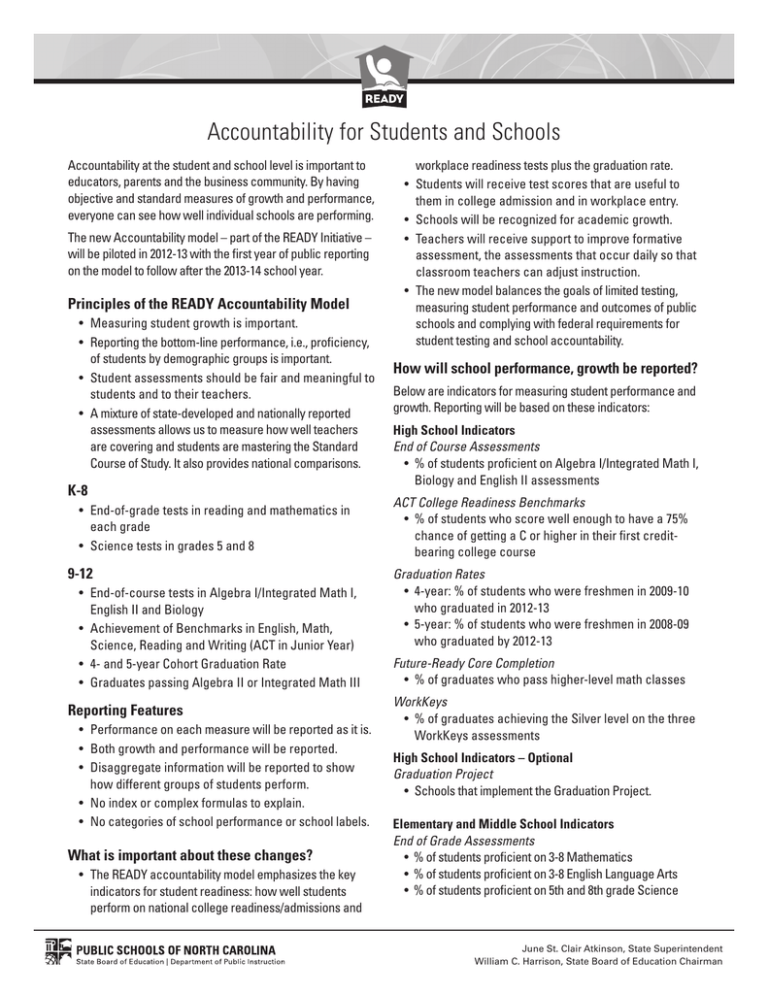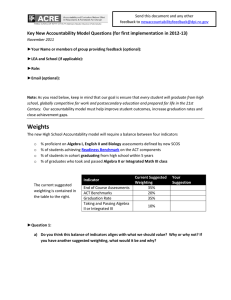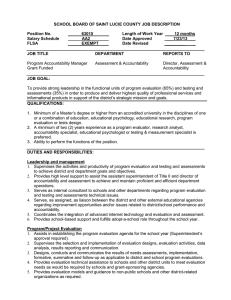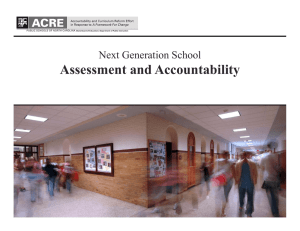Accountability for Students and Schools
advertisement

Accountability for Students and Schools Accountability at the student and school level is important to educators, parents and the business community. By having objective and standard measures of growth and performance, everyone can see how well individual schools are performing. The new Accountability model – part of the READY Initiative – will be piloted in 2012-13 with the first year of public reporting on the model to follow after the 2013-14 school year. Principles of the READY Accountability Model • Measuring student growth is important. • R eporting the bottom-line performance, i.e., proficiency, of students by demographic groups is important. • Student assessments should be fair and meaningful to students and to their teachers. • A mixture of state-developed and nationally reported assessments allows us to measure how well teachers are covering and students are mastering the Standard Course of Study. It also provides national comparisons. K-8 • E nd-of-grade tests in reading and mathematics in each grade • Science tests in grades 5 and 8 9-12 • E nd-of-course tests in Algebra I/Integrated Math I, English II and Biology • Achievement of Benchmarks in English, Math, Science, Reading and Writing (ACT in Junior Year) • 4- and 5-year Cohort Graduation Rate • Graduates passing Algebra II or Integrated Math III Reporting Features • Performance on each measure will be reported as it is. • B oth growth and performance will be reported. • Disaggregate information will be reported to show how different groups of students perform. • No index or complex formulas to explain. • No categories of school performance or school labels. What is important about these changes? • T he READY accountability model emphasizes the key indicators for student readiness: how well students perform on national college readiness/admissions and • • • • workplace readiness tests plus the graduation rate. Students will receive test scores that are useful to them in college admission and in workplace entry. Schools will be recognized for academic growth. Teachers will receive support to improve formative assessment, the assessments that occur daily so that classroom teachers can adjust instruction. The new model balances the goals of limited testing, measuring student performance and outcomes of public schools and complying with federal requirements for student testing and school accountability. How will school performance, growth be reported? Below are indicators for measuring student performance and growth. Reporting will be based on these indicators: High School Indicators End of Course Assessments • % of students proficient on Algebra I/Integrated Math I, Biology and English II assessments ACT College Readiness Benchmarks • % of students who score well enough to have a 75% chance of getting a C or higher in their first creditbearing college course Graduation Rates • 4-year: % of students who were freshmen in 2009-10 who graduated in 2012-13 • 5-year: % of students who were freshmen in 2008-09 who graduated by 2012-13 Future-Ready Core Completion • % of graduates who pass higher-level math classes WorkKeys • % of graduates achieving the Silver level on the three WorkKeys assessments High School Indicators – Optional Graduation Project • Schools that implement the Graduation Project. Elementary and Middle School Indicators End of Grade Assessments • % of students proficient on 3-8 Mathematics • % of students proficient on 3-8 English Language Arts • % of students proficient on 5th and 8th grade Science June St. Clair Atkinson, State Superintendent William C. Harrison, State Board of Education Chairman





